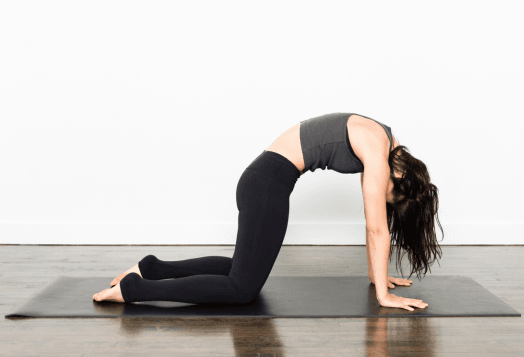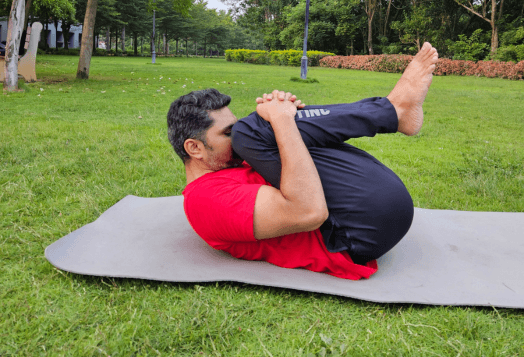
Feeling heavy after meals? Struggling with bloating that makes you uncomfortable? Your gut is trying to tell you something.
Ancient yogis understood what science now confirms—your digestive health affects your entire well-being. Yoga asanas for digestion can help transform how your body processes food.
How Does Yoga Help With Digestive Issues
Yoga asanas specific to digestive health, much like those used in weight loss yoga for beginners, work on multiple levels to support your gut. When you practice yoga, you activate your parasympathetic nervous system—the ‘rest and digest’ mode that's essential for proper digestion. This calming response reduces stress hormones like cortisol, which can disrupt digestive function when elevated.
The gentle yoga asanas for the digestive system create a natural massage for your abdominal organs. Twisting poses squeeze and release your intestines, liver, and stomach, improving blood flow and stimulating peristalsis—the wave-like muscle contractions that move food through your digestive tract. Research shows that regular yoga practice can improve gastric motility and reduce bloating.
Yoga for gut health also addresses the gut-brain connection. Studies reveal that serotonin (your ‘happy hormone’) is produced in your gut. When you reduce stress through yoga, you support healthy gut bacteria and improve the communication between your brain and digestive system.
Yoga Poses for Digestion: Step-by-Step Guide
These carefully chosen poses work synergistically to support your digestive system. Each movement creates specific benefits, from massaging internal organs to reducing stress that interferes with healthy digestion. Practice these poses 2-3 hours after eating for optimal results.
1. Cat-Cow Pose (Marjaryasana-Bitilasana)

Start on hands and knees, wrists under shoulders and knees under hips. Inhale, arch your back and lift your chest (Cow). Exhale, round your spine toward the ceiling (Cat). Repeat 8-10 times with breath awareness.
Why it helps: The alternating spinal flexion and extension create a gentle massage for your abdominal organs. This rhythmic movement stimulates the vagus nerve, which controls digestive function. The compression and release action improves blood circulation to your stomach, liver, and intestines.
2. Seated Forward Bend (Paschimottanasana)

Sit with legs extended, spine tall. Inhale, lengthen your spine. Exhale, fold forward from your hips, reaching toward your feet. Hold for 1-2 minutes, breathing deeply.
Why it helps: This pose creates beneficial abdominal compression that helps release trapped gas and reduces bloating. As you compress your abdomen, you're stimulating the internal organs and promoting better digestion. The gentle pressure also helps regulate bowel movements.
3. Wind-Relieving Pose (Pawanmuktasana)

Lie on your back, hug your right knee to your chest. Hold for 30 seconds, then switch legs. Finally, hug both knees to your chest, gently rocking side to side.
Why it helps: True to its name, this pose directly addresses trapped gas and bloating. The compression against your abdomen stimulates the ascending, transverse, and descending colon, helping to release gas naturally. The gentle pressure also massages your digestive organs and can provide immediate relief from discomfort.
4. Supine Twist (Supta Matsyendrasana)

Lie on your back, bring your right knee to your chest, then cross it over to the left side. Extend your right arm out, keeping both shoulders on the ground. Hold for 1-2 minutes on each side.
Why it helps: Twisting poses are particularly powerful yoga asanas for digestion because they create a wringing action that massages your internal organs. This movement promotes detoxification and improves digestive function. The twisting action also helps release tension in your spine and can alleviate lower back pain, often associated with digestive issues.
5. Child's Pose (Balasana)

Kneel on the floor, sit back on your heels, then fold forward with arms extended or resting alongside your body. Rest your forehead on the mat and breathe deeply for 2-3 minutes.
Why it helps: This restorative pose activates your parasympathetic nervous system, creating the ideal state for digestion. The gentle compression on your abdomen provides a soothing massage to your digestive organs. Child's Pose also reduces stress and anxiety, which can significantly impact digestive health. It's particularly beneficial for calming an irritated gut.
6. Cobra Pose (Bhujangasana)

Lie face down, place palms under your shoulders. Press down through your hands and lift your chest, keeping your pelvis on the ground. Hold for 15-30 seconds, then lower slowly.
Why it helps: The gentle backbend stretches your abdominal muscles and increases blood flow to your digestive organs, similar to its effects in yoga for glowing skin. The opening through your chest and abdomen also counteracts the effects of poor posture, which can compress your digestive organs and impair function.
Additional Yoga Tips for Better Digestion
1. Practice on an empty stomach:
Yoga poses for the digestive system should be done at least 2-3 hours after eating. This allows your body to begin the digestive process without interference.
2. Combine with pranayama:
Deep breathing exercises like the three-part breath (Dirga Pranayama) enhance the digestive benefits of your practice. The diaphragmatic breathing massages your organs and reduces stress.
3. Stay hydrated:
Drink warm water before and after your practice to support healthy digestion. Avoid cold drinks, which can slow digestive fire according to Ayurvedic principles.
4. Practice regularly:
Consistency is key when it comes to yoga for gut health. Even 10-15 minutes daily can create significant improvements in digestive function over time.
5. Listen to your body:
If any pose causes discomfort, ease out immediately. Your practice should feel gentle and supportive, never forced or painful.
Let Yoga Support Your Gut Every Day
Yoga for gut health offers a natural, gentle path to better digestion and overall well-being. By combining mindful movement with stress reduction, you can transform how your body processes food and find relief from common digestive issues. Start with just 10 minutes daily and notice how your body responds to this ancient wisdom. Use Pyng to connect with certified yoga instructors for personalised yoga sessions that address your specific needs and goals.
Disclaimer: This article is intended for informational purposes only and is not a substitute for professional medical advice, diagnosis, or treatment. Always consult a certified expert before starting any new exercise, yoga routine, or breathing technique.




